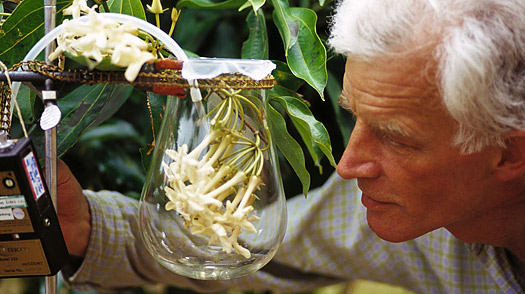
Roman Kaiser, chemist, botanist and perfumer at the Givaudan fragrances and flavors company uses headspace technology to capture the truest impression of a scent in its natural environment.
(2 of 2)
While learning from the past, students must also embrace the present. They are encouraged to see exhibitions, go to movies and hang out — to the point that the request of a student who wanted to condense the course into two years was refused because working late would interfere with his life outside school. "We can teach technique, but we are not able to teach ideas," says Guichard. "We always say that when a perfume is successful, it is not just luck. It is because it translates the idea of its time, exactly like music or like fashion." As for outside influences, Lie, who numbers Ralph Lauren Romance Men, Paul Smith London and Davidoff Adventure among a string of hits in the men's market, loves the movies of Martin Scorsese and is developing a scent for which the brief includes the words American and tough. So he's listening to Johnny Cash on his iPod.
Some of the greatest perfumes have been created by those at the beginning of their career, when their fresh ideas are matched with enough technical skill. "But the balance is very fragile. There can be a time when everything is very easy, and then, later on, you can be out of touch," counsels Guichard, who says he is relieved that often, late in their career, perfumers get what the French call un deuxieme souffle (a second wind). Guichard likens the life of a perfumer to that of an actor. One minute you're the hot young buck, and everyone thinks your life is wonderful, even though you've slept in your car to get there. Then you wake up one day too old to play young and too young to play old. Things get better much later, when the character roles start coming in.
Perfumers work in close partnership with the marketing czars of the global beauty business, such as Estee Lauder and Elizabeth Arden (companies that also, confusingly, might be fragrance creators, as some employ in-house perfumers). While the likes of L'Oreal have the overall know-how — from deciding which designer or singer to sign to choosing the bottle, packaging, image and name — Givaudan or one of its few competitors in sensory innovation gets called in to supply "the juice," a process in which the client is extremely collaborative. The person whose name is on the bottle, however, may not be collaborative at all, although those who play an active role can reap dividends. President of fragrance Carlos cites Tom Ford, "who has a great sense of smell and is deeply involved," and Sean John's Sean (Diddy) Combs as being among those who have seen their efforts repaid hand-somely. "Sean worked really hard for 18 months," recalls Carlos. "He knew he wanted something that was a really high quality with a strong signature. And he would smell what was being done, and then he would wear it out in the evening and see what type of response he would get. And he'd come back the next morning and talk about what people thought, and he kept doing that until everyone was satisfied." The result: Unforgivable is a best seller and an industry award winner. Of course, other factors, including the racy advertising, have contributed to that success. "I think when men buy it, they are thinking of those three girls in the bed, no?" says Guichard, with a twinkle in his eyes.
While some fragrances are tweaked to keep them current, most of the classics have had to be reformulated to comply with International Fragrance Association standards. Natural civet, from a catlike creature of the same name, musk from deer and castoreum from beaver are no longer used. The challenge for today's perfumers is to replace these elements with safe and ethical alternatives without consumers' detecting that their favorite scent has changed.
Faced with dwindling supplies of sandalwood, a key note in many great fragrances, including Must de Cartier, Givaudan has embarked on an initiative in Western Australia to sustainably harvest the precious sandalwood oil. The harvest is strictly controlled by the federal government and profits local indigenous communities. There are also more-modern options. Using a biotechnical innovation known as headspacing, company scientists set off into jungles and swamps on what Givaudan calls ScentTreks, carrying a device that looks something like a goldfish bowl. Instead of plucking a rare orchid and transporting it back to a lab to extract its essential oil, the scientists invert the device over the flower in situ to capture an exact synthesis of its smell. The orchid is left completely intact, growing exactly where it was.
Then again, sometimes the very simplest action leads to success. One of the most famous legends of fragrance is that of Fracas, born when a young woman named Germaine Cellier took a vial of what would become L'Air du Temps from the man working next to her and added an almost indecent amount of -tuberose, the sexiest of all the florals. A fragrance that has endured 61 years was thus created in about six minutes. A period of two to three years is more realistic, although modern perfumers saw that time frame shrink in recent years as they hurried to meet deadlines to get each new "juice" to market. (Lie says he counts himself lucky to have had a year and a half to develop Armani Code.)
"To feel passion but to be without pressure is very important for creation," says Guichard. For the perfumer-teacher tries to ensure that his students remember the key ingredient with no scent at all — time.